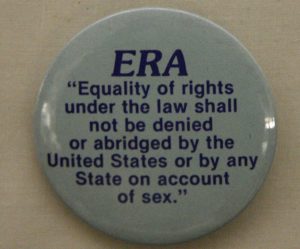
The text is rather simple, stating, in part, «Equality of rights under the law shall not be denied or abridged by the United States or by any State on account of sex.», but the journey of the Equal Rights Amendment is anything but simple. Recently a constitutional and legal battle has reignited over the Equal Rights Amendment, as the two year anniversary of the 38th state to ratify the amendment just passed. On January 27, 2020 Virginia became the 38th state to ratify the ERA, after its initial approval by Congress in 1972. Language set out in the amendment states that the law would take effect two years after ratification, January 27, 2022, yet the status of the ERA is still very much undecided.
Article V of the Constitution grants authority and describes the amendment process. The Constitution outlines two possible pathways an amendment may take, from inception to ratification to inclusion in the U.S. Constitution. The first is by a constitutional convention called for by two-thirds of the State legislatures. The states send delegates to this convention, where they propose amendments to the Constitution. This is followed by three-fourths of states ratifying an amendment approved by the convention, either by their legislatures or special ratifying conventions. This pathway has never yielded an amendment to the Constitution.
The second, and much more popular, pathway involves two-thirds of both houses of the U.S. Congress to pass a proposed amendment. Upon passage, the proposed amendment is sent to the states for ratification. Three-fourths of the states (38 states) must ratify the proposed amendment either by their legislatures or special ratifying conventions. Upon ratification, the Office of Federal Registry verifies that it has received the required number of authenticated ratification documents; it then drafts a formal proclamation for the Archivist to certify the amendment is valid and has become part of the Constitution. From there, the certification is published in the Federal Register and U.S. Statutes at Large and serves as official notice to the Congress and country of the amendment’s addition to the Constitution.
The ERA, originally introduce in 1923, has passed many of the thresholds necessary in order to be the 28th Amendment of the Constitution. It garnered the two-thirds vote in Congress, and was ratified by 38 states, but time limits and a changing political landscape have stood in the way of ERA proponents’ celebrations. In 1972, when Congress originally approved the amendment, they included a deadline on state ratification of 1979 in the preamble. By the deadline only 35 states had ratified. Congress extended the deadline to 1982, but no new states had ratified. It has only been after the Congressional deadline that the necessary number of states ratified the amendment: Nevada in 2017, Illinois in 2018 and finally Virginia. Thus the beginning of the complications surrounding the ERA.
Five states who had once ratified the ERA, have since voted to rescind their ratification (Idaho, Kentucky, Nebraska, South Dakota and Tennessee). Historically, courts have not recognized attempts to rescind ratification of other amendments, so it is unclear how a court would rule on a case brought by one of these five states regarding the ratification of the ERA. Additionally, in 2020, under President Trump’s administration, the Department of Justice issued a memo stating that the 1979 deadline to ratify the ERA was valid and the states that voted to ratify the ERA after the fact had missed the deadline. The national archivist cited this memo in their refusal to add the ERA to the Constitution.
Under the current President Biden administration, the DOJ issued a new memo stating that the prior opinion «is not an obstacle either to Congress’s ability to act with respect to ratification of the ERA or to judicial consideration of questions regarding the constitutional status of the ERA.» For almost one hundred years the Equal Rights Amendment has remained a hotly debated topic and with more court battles and possible Congressional actions to solidify the ERA as the 28th Amendment on the horizon it looks as if the debate will continue.
This week’s Current Events resources examine the Equal Rights Amendment. The resources shared provide historical context and information regarding the history and current Constitutional issues surrounding the status of the ERA. To see additional resources on Constitutional amendments, check out our initial Current Event on the topic.
Looking for more current events resources? Sign up at our We the Teachers Educator Resource Community page, where you can find all of our Current Events, and learn about our other programs!
Essential Questions, Vocabulary & Extend the Resources:
- What is the proposed Equal Rights Amendment?
- What is the history of the Equal Rights Amendment?
- Why was the Equal Rights Amendment proposed?
- What is the process of ratifying a new amendment into the U.S. Constitution?
- What are the arguments both for and against the passage of the Equal Rights Amendment?
- What is Congress’ role in the passage of an amendment? How has Congress directly effected the status of the Equal Rights Amendment?
- In your opinion, should the Equal Rights Amendment be added to the Constitution? Explain.
Click here for a hardcopy of the Essential Questions & Equal Rights Amendment Vocabulary
Click here for a hardcopy of the Extend the Resources handout with suggested lesson activities and extensions
Videos:
Podcasts:
Is the Equal Rights Amendment Now Law?, The Takeaway, NPR, January 31, 2022
The Equal Rights Amendment, Civics 101
Why is the Equal Rights Amendment still not ratified?, Stuff You Should Know, March 4, 2021
Back to the Future: The ERA, Equal Time with Mary C. Curtis, Roll Call, March 25, 2021
Background Resources:
Proposed Amendment, H.J. Res. 208 (Equal Rights Amendment), United States Government Information, GPO
Statement from President Biden on the Equal Rights Amendment, The White House, January 27, 2022
The Equal Rights Amendment Explained, Brennan Center for Justice, January 23, 2020
Recent Articles:
The never-ending fight over whether to include the Equal Rights Amendment in the Constitution, The Washington Post, January 31, 2022
House Democrats introduce resolution to ratify ERA to U.S. Constitution, Axios, January 27, 2022
House Dems seek to advance Equal Rights Amendment after new DOJ opinion, The Hill, January 27, 2022
1970s relic no more: The Equal Rights Amendment is about to take effect. Or not., Reuters, January 26, 2022
First Circuit Declines to Rehear Equal Rights Amendment Case, Bloomberg Law, January 5, 2022
Recent Editorials:
Why Can’t We Make Women’s Equality the Law of the Land?, The New York Times, January 28, 2022
There’s no deadline on women’s equality. Add the Equal Rights Amendment to the Constitution., The USA Today, March 16, 2021
Who has been left out of the history of the Equal Rights Amendment battle? Men., The Washington Post, July 6, 2021
It’s Time to Amend the Constitution, Politico, January 8, 2022
Lesson Plans:
Equal Rights Amendment, Stanford History Education Group
The Equal Rights Amendment (ERA), C-SPAN Classroom
Old Enough to Vote, Upfront
The Equal Rights Amendment: A 97-Year Struggle, Facing History & Ourselves
Exploring the Equal Rights Amendment, PBS Learning Media
Alice Paul and the Equal Rights Amendment (Lucretia Mott Amendment), 1923, Bill of Rights Institute
The Equal Rights Amendment: Viewing Women’s Issues Through Political Cartoons, History Teaching Institute, The Ohio State University
Media & News Literacy Lesson Plans:
Media Literacy Resources – Newseum
Resource Library – News Literacy Project
News & Media Literacy Lessons – Common Sense
Media Misinformation, Viral Deception, and «Fake News» – University of Wyoming
Evaluating Sources in a ‘Post-Truth’ World: Ideas for Teaching and Learning About Fake News – New York Times Lessons




